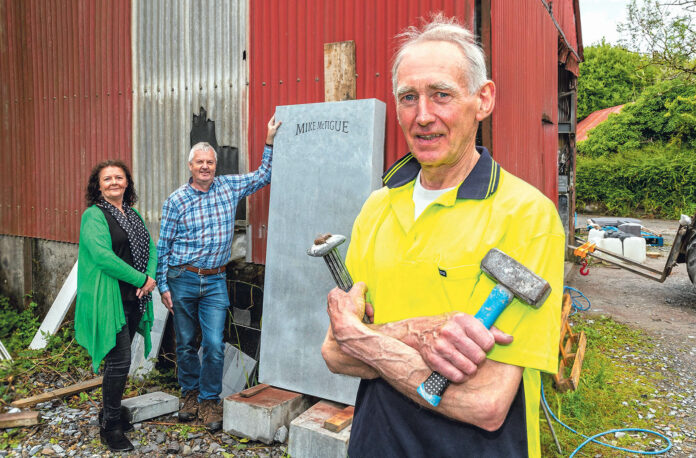PROBABLY unknown to most younger readers, Kilnamona’s Mike McTigue is one of Clare’s all time sporting heroes, having won the World Light Heavyweight Title in 1923.
With the centenary approaching, the world champion’s namesake Michael McTigue is going to create a new monument to one of Kilnamona’s most illustrious sons.
Michael is actually a distant relative of the boxer, while locals Nicholas Rynne, Kevin Rynne and Antoinette McCormack are grand nephews and a grand niece of the man who took the belt.
With the Civil War raging around Dublin, McTigue won the title on St Patrick’s Day, 1923, with a points victory over Senagalese fighter Battling Siki.
Unlike today when there are numerous belts and four major sanctioning bodies, in 1923 there was just one world champion. At light heavyweight, McTigue was the man.
The story of the fight is worthy a book in itself, with Siki having recently become the champion against the odds; McTigue being an outsider but getting a controversial decision; the fact that it was taking place in a city in the grip of Civil War, with the anti Treaty side trying to force its cancellation.
See TG4 documentary on the fight and its background below
Born in 1892, McTigue emigrated to America while in his early twenties, and while he wasn’t a boxer before leaving, Michael (the sculptor) says he was known for his athletic ability.
“He was an outstanding sportsman. There was a guy called Jack Lyons in Toonagh, he’d often come in talking about him. There used to be sports in different parish, he went to Kilfenora one day and won everything there.
“Jack said that when he left to go to America he walked all the way to Cobh, he was the type of fella who wouldn’t open a gate, he’d take a running jump over it,” said Michael
But it was only on the far side of the Atlantic, in the tough working environment at the New York Docks in the 1920s, that his ability as a pugilist was discovered.
“He was discovered brawling around the docks in New York. There’s a TV documentary on him, one of the opening comments was that it was a good place for a man to learn if he could fight!
“Some guy saw him in action against a couple of fellas, he laid them out, and he said ‘you should be in the ring’.”
While he was known as a puncher on the docks, he had plenty of ring craft, and in 1923 that was what won him the title against the heavy hitter from Senegal.
“He wasn’t a spectacular heavy hitter, he was scientific. People say it was touch and go whether Siki won it or not, but if you look at it closely Battling Siki, the reigning champion, was throwing wild punches without hitting anything. Mike kept retreating and picking him off.”
Nowadays professional boxing has a maximum of 12 rounds per fight, and most fights that go the full distance see both boxers exhausted.
However the safety of fighters wasn’t such a priority in 1923, and McTigue and Siki fought a draining 20 rounds, with Siki dominating the first half, with the Kilnamona man on top in the closing stages.
Today all fights are scored round by round by ringside judges, but at the time it was all on the basis of the referee’s overall impression and England’s Jack Smith gave the decision to McTigue, which was obviously popular with the partisan Dublin crowd.
That the fight was made at all relied on a lot of good fortune for McTigue, starting with Siki taking the world title against the odds.
“Mike had married a Kerry woman and as he was coming back to Ireland, he went via England to fight a few fights, to make a few quid.
“It came to pass that the reigning world champion Georges Carpentier was defeated by Siki in five rounds in Paris.
“Siki, from Senegal, being black, was facing racism and he couldn’t get a title defence (in the UK).
“But Ireland was outside of the realm of the Empire at the time and an opportunist by the name of Tom Singleton said he could arrange a fight in Ireland to defend his title.
“He got a hold of Mike McTigue and it was set up for the La Scala theatre on St Patrick’s Day 1923.”
Having caused a huge upset in Paris, Siki was probably undaunted about coming to another European capital for his first defence, but Dublin was in chaos at the time.
“There was a story told about Siki, coming in from his training camp, he saw all these army fellas and he thought it was some kind of reception, he didn’t realise there was a war on. He barely had a word of English.”
Some footage of the fight is available on YouTube, but Mike managed to get his hands on a more extensive recording, after some research and persistence.
“I have a friend John Fitzpatrick in the Bronx and I’d go over and visit him. I always knew this fight was in existence so we set about finding it one day. We ended up in Manhattan at a company called the Big Fights Incorporated. They had it and they owned the rights.
“I got a hold of someone and they said it’s a very well known fight. I said I’m related, and he brought us in and showed it on a reel to reel thing.
“After about a year of cajoling them and nagging them they agreed to give us a copy provided we wouldn’t show it in public.”
Mike’s father was known around Kilnamona as the Cipin, and he was in the ring straight away afterwards.
“There’s a lovely scene at the end of it. he was inside in the ring lifting Mike up in the air.”
McTigue had enjoyed a colourful life and career, but there was plenty more to come, and he defended the title that October in Georgia.
“An Irish man in Georgia in the 1920s wasn’t very welcome, it was very racist. He fought the local guy, Young Striblig, and the Ku Klux Klan surrounded the ring with guns and they declared Stribling the winner.
“Mike and the referee had to run for their lives, and he was awarded the fight subsequently. He was told before the fight he could pick the tree he wanted to hang from!”
McTigue would hold the title until 1925, when he was defeated by Paul Berlenbach at Yankee Stadium. Two years later he would avenge the defeat, knocking out Berlenbach at Madison Square Garden.
In total he fought 174 times as a professional, and finally retired in 1930.
After retirement he ran a bar on Long Island, but suffered from bad health in his latter years, and was confined to hospital. He passed away in 1966, and was survived by his wife and two daughters.
Somehow his achievements have become somewhat forgotten in recent years, but Mike says he was still a household name at the time of his death.
“He died in August of 1966. I started secondary school in St Flannan’s in September. When you stood up in class and introduced yourself you were immediately asked if you were related to the boxer.
“It would have been on the RTE news when he died, Gene Tunney would have been at his funeral.”
After his triumph over Siki, there wasn’t another world title fight in Ireland until Barry McGuigan’s first Irish defence in the mid-1980s.
Now, plans are in place for a monument in Kilnamona and speaking about it Mike says, “I’m going making a low relief sculpture, I’m doing it for free except for the cost of the stone, so it’s not feasible to do a full blown statue, but it’ll be a larger than life size image of Mike McTigue.”
It would be very fitting to have it at Kilnamona Cross, he feels.
“Kilnamona cross is the focal point of the parish and we’d kind of envisage it’d be the first significant thing any tourist will see when they are headed for Ireland’s biggest tourist attraction.
“It’ll make Kilnamona a gateway apart from anything else. It’s an ideal place to give him the prominence he deserves, having been neglected for so long. A lot of people don’t even know about him.”
The project actually began a few years ago, but, like many things, it faced serious delays.
“We began this a few years ago, but with Covid it was put on the back burner, but now we’re on the home stretch.”
Owen Ryan has been a journalist with the Clare Champion since 2007, having previously worked with a number of other publications in Limerick, Cork and Galway. His first book will be published in December 2024.



